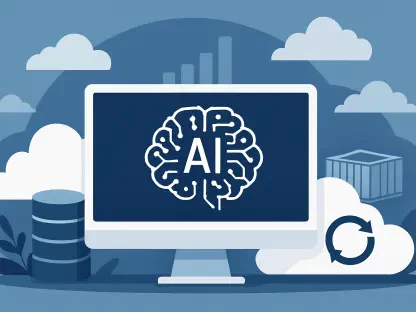The rapid integration of artificial intelligence (AI) into enterprise IT is becoming an unavoidable reality. From generative AI (GenAI) tools to data management and employee productivity, AI’s influence is significant. However, this integration is not without its challenges. The following article delves deeply into the hurdles and advantages that come with AI adoption in enterprise IT, offering insights from thought leaders at the Gartner IT Symposium/Xpo.
AI is currently surrounded by considerable hype, yet it remains in its nascent stages. Enterprises must navigate a complex landscape to effectively harness AI’s potential. According to Hung LeHong, a distinguished VP analyst at Gartner, the path to AI adoption varies among companies, with some preferring a steady pace and others opting for accelerated integration based on their goals.
Current and Future Spending on Generative AI
John-David Lovelock points out that much of today’s spending on GenAI is led by tech companies building foundational infrastructure. Most corporate investments in GenAI will escalate beyond proof-of-concept phases beginning in 2025. Expectations surrounding GenAI capabilities may temper over time, as the practical achievements of current models fall short of soaring anticipations. This means that while technology companies are creating the necessary foundation, other enterprises must prepare to invest significantly in GenAI soon to stay competitive.
Between 2023 and 2028, the impact of GenAI on server sales is projected to almost triple. This dramatic growth underscores the transformative potential of GenAI, yet also serves as a reminder of the need for judicious planning and investment. Businesses must align their GenAI investments with realistic expectations and practical applications to avoid disappointment and underperformance. As firms move beyond the initial excitement of GenAI, they must also focus on infrastructure scalability and long-term sustainability.
Decentralized AI and Data Management
The decentralization of AI and data within enterprises marks a significant shift in how organizations manage technological resources. A Gartner survey reveals that only 35% of AI capabilities are built by IT teams, necessitating novel strategies for managing data access and governing AI inputs and outputs. This decentralization means that various departments within a company will likely develop their own AI solutions, necessitating a coordinated approach to manage this new complexity effectively.
This decentralization presents both challenges and opportunities. Effective data governance becomes crucial to safely and efficiently delivering AI value across varied organizational units. Firms must adapt to manage resources in a decentralized AI ecosystem to ensure consistency and reliability in AI-driven outcomes. The key to success lies in developing comprehensive data management strategies that allow for flexibility while maintaining strict standards and guidelines. This ensures that even with decentralized AI projects, the organization remains aligned in its objectives and methodologies.
Employee Productivity and Behavioral Outcomes
A Gartner survey of over 5,000 digital workers reveals that GenAI tools save employees an average of 3.6 hours per week. However, productivity benefits are not uniformly experienced, as these gains vary depending on job complexity and individual experience. The human element of AI adaptation also surfaces, with some employees feeling threatened or resentful toward AI tools. These mixed reactions highlight the need for enterprises to consider both technological and psychological dimensions when implementing AI solutions.
Such behavioral outcomes can include jealousy or overdependence on AI, which few organizations currently manage effectively. In fact, only 20% of CIOs focus on mitigating AI’s negative impact on employee well-being. Successfully navigating these human factors is as critical as technological readiness for comprehensive AI integration. For AI to genuinely enhance productivity without causing friction, businesses must develop robust change management strategies that address employee concerns and provide clear guidance on leveraging AI tools effectively.
Financial Implications and Risks
Managing AI-related costs is a predominant concern among over 90% of CIOs, as indicated in a Gartner survey. Misunderstood or unexpected costs can lead to significant financial miscalculations, making cost management as critical as security or risk management. Enterprises need to develop strong financial strategies to anticipate and mitigate these costs proactively, ensuring that their AI initiatives remain sustainable and within budget.
Gartner warns that improper cost scaling could result in errors ranging from 500% to 1,000%. Enterprises must commit to thorough planning and cost analysis to avoid financially crippling mistakes and to maximize ROI from AI investments. Close collaboration between technical and financial departments is essential to develop realistic budgets and contingency plans. By understanding the full scope of AI-related expenses, from initial setup to ongoing maintenance, organizations can make more informed decisions that support long-term success without sacrificing financial stability.
Sentiment Analysis and Workforce Manipulation
AI’s capability to analyze workplace sentiment and behaviors represents a double-edged sword. By 2028, it is predicted that 40% of large enterprises will utilize AI to influence and measure employee moods and behaviors to ensure alignment with desired outcomes. While this could potentially boost employee motivation and engagement, it also raises significant ethical concerns. Companies must carefully consider the boundaries of AI’s role in workforce management to avoid overreach and ensure that AI is used responsibly.
These insights hold potential benefits but also ethical risks of manipulating workforce sentiment, necessitating a cautious and well-considered approach to implementation. Ensuring ethical AI practices means developing transparent policies and involving employees in discussions about AI’s role in the workplace. Balancing organizational goals with employee autonomy is essential for creating a work environment where AI augments human capabilities without infringing on personal freedoms or privacy.
Organizational Restructuring
AI-driven processes are poised to revolutionize organizational structures fundamentally. By 2026, it’s anticipated that a significant portion of middle management positions will be eliminated due to AI’s capability to streamline processes and reduce bureaucratic layers. This shift will enable organizations to operate more efficiently, reducing labor costs and improving decision-making processes. However, this transition also requires careful planning and support to manage its broader social and operational impacts.
This restructuring will not only lower labor costs but also enable organizations to gain long-term efficiency. Companies must prepare for the transition by developing strategies to re-skill displaced workers and manage the organizational culture shift. Emphasizing continuous learning and adaptability within the workforce can help mitigate potential disruptions and turn this challenge into an opportunity for overall growth. Effective communication and leadership will be crucial in guiding organizations through these significant changes.
Evolution of Generative AI Capabilities
Generative AI is evolving rapidly, with advancements in technology continually expanding its application spectrum. The use cases for GenAI will likely go beyond current popular tools, such as ChatGPT, driven by innovations in multimodal and instruction-trained foundational models. These new developments promise capabilities that are more specialized and versatile, allowing enterprises to leverage AI for a broader range of tasks and business processes.
This evolution will create a new wave of applications supported by an increasingly sophisticated ecosystem of tools and techniques for building, governing, and customizing AI applications. Staying ahead of these changes will be essential for enterprises seeking to capitalize on AI’s full potential. Companies that invest in continuous learning and skill development will be better positioned to adopt and integrate these new technologies quickly. By keeping pace with advancements, organizations can unlock new opportunities and maintain a competitive edge in an ever-evolving market.
Developing Minimum Viable Products
The decentralization of AI and data within enterprises marks a significant evolution in how organizations manage their technological resources. According to a Gartner survey, just 35% of AI capabilities are developed by IT departments, which necessitates new strategies for managing data access and governing AI inputs and outputs. This decentralization implies that various departments within a company are likely to develop their own AI solutions, requiring a coordinated approach to effectively handle this complexity.
This shift introduces both challenges and opportunities. Effective data governance becomes crucial for safely and efficiently delivering AI value across different organizational units. To ensure consistency and reliability in AI-driven outcomes, companies must adapt to managing resources within a decentralized AI ecosystem. Success hinges on developing comprehensive data management strategies that provide flexibility while maintaining strict standards and guidelines. This approach ensures that even with decentralized AI projects, the organization remains aligned in its objectives and methodologies, fostering a cohesive and efficient operational framework.









